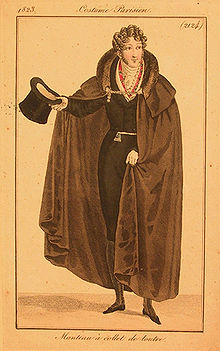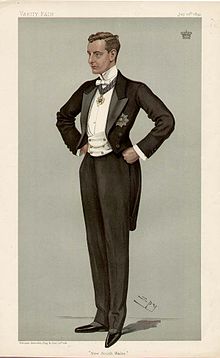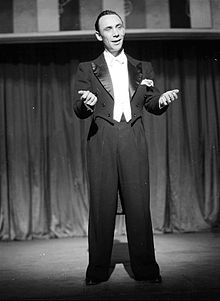White tie


| Part of a series on |
| Western dress codes and corresponding attires |
|---|
|
Legend:
|
White tie, also called full evening dress or a dress suit, is the most formal in traditional evening western dress codes.[1] For men, it consists of a black dress coat with tails worn over a white shirt, Piqué waistcoat and the eponymous white bow tie worn around a standing wingtip collar. High-waisted black trousers and patent leather oxford or optionally court shoes complete the outfit. Orders insignia and medals may be worn. Acceptable accessories include a top hat, white gloves, a white scarf, a pocket watch and a boutonnière. Women wear full-length ball or evening gowns and, optionally, jewellery, tiaras, a small handbag and evening gloves. Some white-tie functions also request that the women wear long gloves past the elbow.
The dress code's origins can be traced back to the end of the 18th century. New fully black-coloured justaucorps styles emerged around the Age of Revolution, notably adopted by the bourgeois third estate of the Estates General of the Kingdom of France. Increasingly following the French Revolution, high society men abandoned the richly decorated justaucorps coats for more austere cutaway dress coats in dark colours, with cuts perhaps further inspired by the frocks and riding coats of country gentlemen. Gradually replacing also breeches, lacy dress shirts and jabots with plain white dress shirts, shorter waistcoats, white cravats and pantaloons, this became known as directoire style. By early 19th century Regency era, dark dress tailcoats with light trousers became standard daywear, while black and white became the standard colours for evening wear. Although the directoire style was replaced for daytime by black frock coats and bowties by mid-19th century, cutaway black dress tailcoats with white bowtie has remained established for formal evening wear ever since.
Despite the emergence of the shorter dinner jacket (or tuxedo) in the 1880s as a less formal but more comfortable alternative, full evening dress tailcoats remained the staple. Towards the end of the Victorian era, white bow ties and waistcoats became the standard for full evening dress, known as white tie, contrasting with black bow ties and waistcoats for the dinner jacket, an ensemble which became known as semi-formal black tie.
Following the counterculture of the 1960s, white tie was increasingly replaced by black tie as default evening wear for more formal events. Since late 20th century, white tie tends to be reserved for the most formal evening occasions, such as state dinners, audiences, in addition to balls and galas such as the Vienna Opera Ball in Austria, the Nobel Prize banquet in Stockholm, Mardi Gras balls in New Orleans, and the Al Smith Memorial Dinner in New York. White tie still also occurs at traditional weddings and church celebrations, at certain societies and fraternities, as well as occasionally around some traditional European universities and colleges.
History




19th century: origins and development

Throughout the Early Modern period, western European male courtiers and aristocrats donned elaborate clothing at ceremonies and dinners: coats (often richly decorated), frilly and lacy shirts and breeches formed the backbone of their most formal attire. As the 18th century drew to a close, high society began adopting more austere clothing which drew inspiration from the dark hues and simpler designs adopted by country gentlemen.[2] By the end of the 18th century, two forms of tail coat were in common use by upper-class men in Britain and continental Europe: the more formal dress coat (cut away horizontally at the front) and the less formal morning coat, which curved back from the front to the tails. From around 1815, a knee-length garment called the frock coat became increasingly popular and was eventually established, along with the morning coat, as smart daywear in Victorian England. The dress coat, meanwhile, became reserved for wear in the evening.[3] The dandy Beau Brummell adopted a minimalistic approach to evening wear—a white waistcoat, dark blue tailcoat, black pantaloons and striped stockings.[4] Although Brummell felt black an ugly colour for evening dress coats, it was adopted by other dandies, like Charles Baudelaire, and black and white had become the standard colours by the 1840s.[5][6]
Over the course of the 19th century, the monotone colour scheme became a codified standard for evening events after 6 p.m. in upper class circles.[2] The styles evolved and evening dress consisted of a black dress coat and trousers, white or black waistcoat, and a bow tie by the 1870s. The dinner jacket (black tie/tuxedo) emerged as a less formal and more comfortable alternative to full evening dress in the 1880s.

By the early 20th century, full evening dress meant wearing a white waistcoat and tie with a black tailcoat and trousers; white tie had become distinct from black tie.[7] Despite its growing popularity, the dinner jacket remained the reserve of family dinners and gentlemen's clubs during the late Victorian period.[2]
20th century

By the turn of the 20th century, full evening dress consisted of a black tailcoat made of heavy fabric weighing 16-18 oz per yard. Its lapels were medium width and the white shirt worn beneath it had a heavily starched, stiff front, fastened with pearl or black studs and either a winged collar or a type called a "poke", consisting of a high band with a slight curve at the front.[8] After World War I, the dinner jacket became more popular, especially in the US, and informal variations sprang up, like the soft, turn-down collar shirt and later the double-breasted jacket;[9] relaxing social norms in Jazz Age America meant white tie was replaced by black tie as the default evening wear for young men, especially at nightclubs.[2] According to The Delineator, the years after World War I saw white tie "almost abandoned".[10] But it did still have a place: the American etiquette writer Emily Post stated in 1922 that "A gentleman must always be in full dress, tail coat, white waistcoat, white tie and white gloves" when at the opera, yet she called the tuxedo "essential" for any gentleman, writing that "It is worn every evening and nearly everywhere, whereas the tail coat is necessary only at balls, formal dinners, and in a box at the opera."[11]
It also continued to evolve. White tie was worn with slim-cut trousers in the early 1920s; by 1926, wide-lapelled tailcoats and double-breasted waistcoats were in vogue.[12] The Duke of Windsor (then Prince of Wales and later Edward VIII) wore a midnight blue tailcoat, trousers and waistcoat in the 1920s and 1930s both to "soften" the contrast between black and white and allow for photographs to depict the nuances of his tailoring.[13] The late 1920s and 1930s witnessed a resurgence in the dress code's popularity,[10][14] but by 1953, one etiquette writer stressed that "The modern trend is to wear 'tails' only for the most formal and ceremonious functions, such as important formal dinners, balls, elaborate evening weddings, and opening night at the opera".[15] It was the dress code for the Lord Mayor of London's Mansion House dinner until 1996.[16]
The last president to have worn white tie at a United States presidential inauguration was President John F. Kennedy in 1961, who wore morning dress for his inauguration, and a white tie ensemble for his inauguration ball.
21st century
While rare in the early 21st century, it survives as the formal dress code for royal and public ceremonies and audiences, weddings, balls, and a select group of other social events in some countries.
Notable international recurrent white tie events include the Nobel Prize ceremony in Sweden,[17] and the Vienna Opera Ball in Austria.[18][deprecated source]
In Scandinavia and the Netherlands, white tie is the traditional attire for doctoral conferments and is prescribed at some Swedish and Finnish universities, where it is worn with a top hat variant called a doctoral hat.[19][20][21][22][23]
Some fraternities such as Freemasons and Odd Fellows wear dress coats to their meetings.[24][25]
United Kingdom
This section needs expansion. You can help by adding to it. (June 2019) |
In Britain, it is worn at certain formal occasions such as state banquets[26][27] and certain balls at Oxford, Cambridge, Durham, and St Andrews universities.[28][29][30] White tie is also seen as part of a few public schools' uniform, such as Harrow School, where the Head Boy is allowed to wear white tie to special events[citation needed].
United States

A few state dinners at the White House apply white tie, such as the one held for Queen Elizabeth II in 2007.[31] Other notable examples include the Gridiron Club Dinner in Washington, D.C., the Alfred E. Smith Memorial Foundation Dinner in New York City, in additions to a few debutante balls such as the International Debutante Ball in New York City, and the Veiled Prophet Ball in St. Louis.
In the southern United States, white tie is sometimes referred to as "costume de rigueur", adapted from French language due to the historical background of New France. It is sometimes used in invitations to masquerade balls and Mardi Gras celebrations, such as the Mardi Gras in Mobile in Alabama,[32][33] or New Orleans Mardi Gras in Louisiana, emphasising the white tie expectations for men and full-length evening gowns for ladies.[33]
When the Metropolitan Museum of Art's Costume Institute Gala in New York City announced a white tie dress code in 2014, a number of media outlets pointed out the difficulty and expense of obtaining traditional white tie, even for the celebrity guests.[34][35]
Composition

According to the British etiquette guide Debrett's, the central components of full evening dress for men are a white marcella shirt with a detachable wing collar and single cuffs, fastened with studs and cufflinks; the eponymous white marcella bow tie is worn around the collar, while a low-cut marcella waistcoat is worn over the shirt. Over this is worn a black single-breasted barathea wool or ultrafine herringbone tailcoat with silk peak lapels. The trousers have double-braiding down the outside of both legs, while the correct shoes are patent leather or highly polished black dress shoes. Although a white scarf remains popular in winter, the traditional white gloves, top hats, canes and cloaks are now rare. Women wear a full-length evening dress, with the option of jewellery, a tiara, a pashmina, coat or wrap. Long gloves are not compulsory.[36]
The waistcoat should not be visible below the front of the tailcoat, which necessitates a high waistline and (often) braces for the trousers. As one style writer for GQ magazine summarises "The simple rule of thumb is that you should only ever see black and white not black, white and black again".[37][38] While Debrett's accepts double cuffs for shirts worn with white tie,[36] some tailors and merchant suggest that single, linked cuffs are the most traditional and formal variation acceptable under the dress code.[39] Decorations may also be worn and, unlike Debrett's, Cambridge University's Varsity student newspaper suggests a top hat, opera cloak and silver-topped cane are acceptable accessories.[40]
Gallery
-
Mustafa Kemal Atatürk in evening white tie formal wear (1925)
-
Fred Astaire portrait for film You'll Never Get Rich (1941)
-
Emperor Hirohito and Empress Nagako of Japan (1956-11)
-
President John F. Kennedy and Mrs. Jacqueline Kennedy with President Félix Houphouët-Boigny and Madame Marie-Thérèse Houphouët-Boigny of the Ivory Coast (1962)
-
President of the United States Gerald Ford, First Lady Betty Ford, Japanese Emperor Hirohito and Empress Nagako during a state dinner, 1975
-
President George W. Bush and Mrs. Laura Bush welcome Queen Elizabeth II and Prince Philip, Duke of Edinburgh, upon their arrival to the White House for a state dinner (2007).
-
King Juan Carlos I and President of Estonia Toomas Hendrik Ilves (2009).
References
Citations
- ^ "White Tie Dress Code". Debrett's. Archived from the original on 23 March 2020. Retrieved 5 April 2020.
- ^ a b c d Marshall, Peter. "A Field Guide to Tuxedos". Slate. Archived from the original on 1 October 2015. Retrieved 30 September 2015.
- ^ Jenkins 2003, p. 886
- ^ Carter 2011
- ^ Williams 1982, p. 122
- ^ Jenkins 2003, p. 887
- ^ Jenkins 2003, pp. 888, 890
- ^ Schoeffler 1973, p. 166
- ^ Schoeffler 1973, p. 168
- ^ a b The Delineator, vol. 128 (January 1936), p. 57
- ^ Emily Post (1922). Etiquette in Society, in Business, in Politics and at Home Archived 2016-01-19 at the Wayback Machine. New York and London: Funk and Wagnalls co. chap. vi, xxxiv
- ^ Schoeffler 1973, pp. 169-170
- ^ "Evening suit". The Metropolitan Museum of Art. Archived from the original on 2 October 2015. Retrieved 1 October 2015.
- ^ Schoeffler 1973, p. 170
- ^ Lillian Eichler Watson (1953). New Standard Book of Etiquette. New York: Garden Publishing Company. p. 358
- ^ Willcock, John (6 June 1996). "A black day for white tie at the Lord Mayor's banquet". The Independent. Archived from the original on 1 October 2015. Retrieved 30 September 2015.
- ^ "The Dress Code at the Nobel Banquet". Nobel Prize. Nobel Foundation. Archived from the original on 9 October 2015. Retrieved 29 September 2015.
- ^ Blake, Matt (28 February 2014). "A fight at the Opera Ball! White tie-clad gents trade punches at Vienna's premier social event, attended by Kim Kardashian". Daily Mail. Archived from the original on 1 October 2015. Retrieved 29 September 2015.
- ^ "Degree conferment celebrations for new PhDs". Uppsala University. Archived from the original on 1 October 2015. Retrieved 29 September 2015.
- ^ "Degree Ceremonies 2006". University of Vaasa. Archived from the original on 8 March 2008. Retrieved 29 September 2015.
- ^ Miller, Beth (31 August 2010). "A sword, a hat and three unforgettable days in Helsinki". Washington University in St Louis. Archived from the original on 1 October 2015. Retrieved 29 September 2015.
- ^ Ditzhuyzen, Reinildis van (2013). De Dikke Ditz: Hoe hoort het eigenlijk? (in Dutch). Haarlem: H. J. W. Becht. p. 292. ISBN 978-90-230-1381-5.
- ^ http://promootio.aalto.fi/fi/history/2014/pukeutuminen/
- ^ Approved Masonic Dress, Aprons, Gauntlets, Collars and Jewels of Rank A Publication of the United Grand Lodge of NSW and the ACT, May 2012
- ^ "Freemasons NSW & ACT - Home". www.masons.org.au. Archived from the original on 2018-11-17. Retrieved 2018-11-20.
- ^ "President Obama hosts star-studded farewell dinner". BBC News. 25 May 2011. Archived from the original on 27 October 2014. Retrieved 30 September 2015.
- ^ Gammell, Caroline (31 October 2007). "Protests, pomp and a PM in white tie". Daily Telegraph. Archived from the original on 5 October 2015. Retrieved 30 September 2015.
- ^ "Magdalen Commemoration Ball cancelled". Cherwell. 12 March 2014. Archived from the original on 1 October 2015. Retrieved 30 September 2015.
- ^ Shan, Fred (1 April 2014). "Mr Shan Menswear: on White Tie". The Oxford Student. Archived from the original on 1 October 2015. Retrieved 30 September 2015.
- ^ "Archived copy". Archived from the original on 2017-03-04. Retrieved 2017-03-04.
{{cite web}}: CS1 maint: archived copy as title (link) - ^ Stolberg, Sheryl Gay (8 May 2007). "A White-Tie Dinner for Queen's White House Visit". New York Times. Archived from the original on 29 April 2013. Retrieved 30 September 2015.
- ^ "Mardi Gras Terminology", Mobile Bay Convention and Visitors Bureau, 2009, webpage: MG-terms Archived 2007-12-09 at the Wayback Machine.
- ^ a b "Le Krewe de Bienville", KrewedeBienville.com, 2011, web: KbD Archived 2016-03-04 at the Wayback Machine.
- ^ Trebay, Guy (23 April 2014). "At the Met Gala, a Strict Dress Code". New York Times. Archived from the original on 26 April 2018. Retrieved 29 September 2015.
- ^ Rothman, Lily (5 May 2014). "The Met Ball Is White Tie This Year—But What Does That Even Mean?". Time. Archived from the original on 25 September 2015. Retrieved 29 September 2015.
- ^ a b "White Tie", Debrett's, archived from the original on 13 September 2015, retrieved 28 September 2015
- ^ Johnston, Robert. "Attire to suit the occasion". GQ. Archived from the original on 1 October 2015. Retrieved 29 September 2015.
- ^ "Evening Tailcoat". Ede & Ravenscroft. Archived from the original on 1 October 2015. Retrieved 29 September 2015.
- ^ "White tie dress code" Archived 2016-03-05 at the Wayback Machine. Savvy Row. Retrieved 26 February 2015.
- ^ Sharpe, James (9 May 2011). "Fix Up, Look Sharpe: Dress codes". Varsity. Archived from the original on 12 September 2015. Retrieved 29 September 2015.
Bibliography
- Philip Carter (January 2011). "Brummell, George Bryan (Beau Brummell) (1778–1840)". Oxford Dictionary of National Biography, online ed. (subscription or UK public library membership required). Retrieved 28 September 2015. DOI 10.1093/ref:odnb/3771
- D. T. Jenkins (2003). Cambridge History of Western Textiles, vol. 1. Cambridge: Cambridge University Press. ISBN 9780521341073
- O. E. Schoeffler (1973). Esquire's encyclopedia of 20th century men's fashions. New York, NY: McGraw-Hill ISBN 9780070554801
- Rosalind H. Williams (1982). Dream Worlds: Mass Consumption in Late Nineteenth-century France. Berkeley and Los Angeles, CA: University of California Press. ISBN 9780520043558
External links
![]() Media related to White tie at Wikimedia Commons
Media related to White tie at Wikimedia Commons









